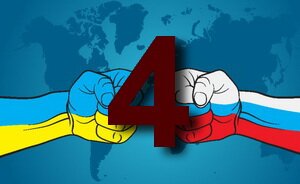
Andrey Pospelov, Candidate of Historical Sciences, Associate Professor of Odesa Mechnikov National University, Full Member (Academician) of the International Academy of Life Safety
Weapons and Military Equipment for the Army of the Armed Forces of Ukraine. Part 4
Armoured vehicles
By the time when Ukraine gained independence, in the structure of its MIC a unique place, no doubt, had been occupied by the armored industry. The level of its development was not just up to the world standards, but also on a number of parameters it had left them behind. However, the main difference between armored industry of Ukraine from other branches of Ukrainian MIC was as follows: almost a completely closed cycle, well-developed infrastructure, and integral by all indicators structure of its businesses.
At the center of this structure is Kharkiv Morozov Design Bureau with pilot production. It is not only one of the three main developers of Soviet battle tanks (the other two are in Leningrad and Nizhniy Tagil), but also the oldest and the most modern in its equipment. The middle link of the Ukrainian armored industry had been two unique enterprises-manufacturers — Kharkiv Malyshev Plant of Transport Engineering with its own manufacturing of diesel engines and Kharkiv Ordzhonikidze Tractor Plant with its Design Bureau. Both the companies at the time of the collapse of the USSR had their own “brands” — the main battle tank T-64 and a light armored transporter-tractor MT-LB.
Finally, to the lower level of the armored industry of Ukraine belonged tank repair plants of the Ministry of Defense. Out of the 22 such companies working at the territory of the Soviet Union, 5 were in Ukraine — Kiev (in Darnitsa), Lviv, Zhytomyr and Kharkiv Armored Repair and Mykolaiv Mechanical Repair Plants. These enterprises could repair and upgrade almost all types of armored vehicles of Soviet designs.
It should be noted that by staffing, organization and culture of production, plants of the Ukrainian armored industry were among the best in the whole industry of the newly born independent state. But even more important was not even that, but the fact that actually the Soviet Ukraine had its own original and creative by all parameters design school of closed character. First of all, because at least two departments (wheeled and tracked vehicles) of Kharkiv Polytechnic Institute (now National University) had been preparing engineering design personnel for the relevant enterprises of this industry.
The armored industry had in Ukraine a number of related companies, developing and manufacturing special equipment and materials for major plants of the industry. Among such companies should be mentioned the “Dneprospetsstal plant” (Zaporizhia), producing various types of steel and alloys, including for armoring, Kharkiv Plant of Propelled Chassis and Kharkiv Plant of Tractor Engines (HZTD). The latter could assemble not less than 125 thousand engines a year, although the vast majority of them was destined for the civilian sector.
A significant drawback of the infrastructure of the armored industry in Ukraine has been and remains its not right, from the strategic point of view, location. Apart from the 4 repair plants and certain related companies, all the capabilities of the domestic production of armored vehicles are geographically concentrated in one city — Kharkiv. During the “Cold War” (when such an infrastructure was formed) it met political and strategic aspects, as Kharkiv was located far from the possible front line with the countries of NATO. Besides, all companies within the industry were properly covered by military units. For example, just next to the tank-building city there was located the 41st Guards Tank Division, which, apart from its main functions, participated in military tests of armored vehicles made in Kharkiv. In Dnipropetrovsk region was stationed the 6th Guards Tank Army, a rear base of which was Kharkiv Armored Repair Plant.
At the present time, when the front of military confrontation with separate DPR and LPR (and the standing behind them Russian Federation) is close enough to the Ukrainian tank building center, and of the former Tank Army( now called “the 6th Army Corps”) in fact there remains only a shadow, such geographical location is quite unreliable. At this the insecurity is such that in case of deployment (on the most pessimistic scenario) of military actions in Kharkiv region and in the city of Kharkiv, Ukraine actually loses the “diamond” of its industry. And to restore it, primarily because of staffing and resource starvation, does not seem possible.
So why is the Ukrainian armored vehicle production unique?
To answer this question, we should look back at its history. And we should start with 1927, when on the basis of the Kharkiv Locomotive Factory (KhPZ) and the Main Design Bureau of Gun-Arsenal Trust for the first time in the Soviet Union was created a tank building enterprise. First experiments with a small series of tanks T-12 and T-24 led to the launch of a massive series of tanks BT-2 (1932), the BT-5 (1933), and BT-7 (1935). Despite the fact that this series was created on the basis of the bought from the USA tank “Christie” (which, by the way, had never been put into mass production), the Kharkiv enterprise had been producing really the best light tank of the interwar period. At this, the pace of manufacturing armored vehicles was impressive even in those days — 22 tanks in one day. And despite the fact that in the years 1933-1939 in a small series of 60 units was being produced a world's unique tank — heavy 5-tower tank T-35.
In 1939, with the creation of a fundamentally new T-34 tank, KhPZ reached a new level of production. Moreover, we mean not just the tank but also the unique diesel engine “V-2”. Both designs are rightly recognized as the best in the 2nd World War and have informal, but absolutely true titles “Tank of the Century” and “Engine of the century”.
Moreover, the evacuation during WWII of the KhPZ to Nizhniy Tagil, and the diesel production — to Barnaul, had led to the creation of new production capacities of this industry at the territory of Russia. And although new plants from 1942 to 1945 had been actually producing constructions developed in Kharkiv, and, with great pace (for example, every 15 minutes from the conveyor in Nizhniy Tagil used to move down a new vehicle), “Kharkivites” always maintained their “autonomy”. The moment the city had been liberated from the invaders, the KhPZ was re-evacuated and in March 1944 began producing a completely new design — medium tank T-44 and diesel “V-44”. Later there appeared postwar T-54 and T-55, which were made both in Kharkiv, and in Nizhniy Tagil.
Despite the fact that the engineering design of Soviet tanks of the first postwar generation and the created in Nizhniy Tagil tank of the second generation — the T-62 (by all their characteristics during the “Cold War” they were better than any tank design of NATO) were out of competition, the search for fundamentally new solutions in tank production in Kharkiv was in full swing.
At last, in 1963, already at the Kharkiv Malyshev Plant of Transport Engineering (HZTM, former KhPZ) was created “Object 432” — the future world's first main battle tank T-64. Kharkiv designers for the first time managed to put on mass production tanks combined armor, automatic charging for separate shots of first 115-mm, and then 125-mm guns, and most importantly — the world's first opposite (i.e. cylinder into cylinder) serial tank engine “5TDF” (by the way, also created in Kharkiv). Uniqueness and high fighting qualities of T-64 were so striking that it has become almost the only Soviet armored object of the postwar period, which was never exported, and its real characteristics became known to NATO experts only after 1991.
Simultaneously, at the HZTM was created and in 1964 went into mass production the light armored transporter-tractor MT-LB. At first glance, there was nothing special about its design. However, the MT-LB had very low ground pressure, which ensured its unique terrain crossing capacity. It also had a very good base for placing different weapons, and this manifested itself in many local conflicts. In fact, the only drawback of the MT-LB was precisely the presence of only one 7.62-mm machine gun in a single tower.
Creation of T-64 (and later — its modifications “A” and “B”) had brought the Ukrainian engineering tank school to the forefront in the USSR. The only disadvantage of the new tank was its cost and, at first, its complexity. That is why the designers of Nizhniy Tagil were tasked to develop a simpler version of the T-64, which, among other things, could be exported. That version later became T-72 tank. But for the Soviet Army on the basis of the T-64 in Leningrad (at the Kirov Plant) was developed a completely new, with a gas turbine engine, tank T-80. It went into the series (including at the HZTM) in 1980.
For all their advantages, T-72 and T-80 could never beat T-64 by characteristics. T-72 had less sophisticated fire control instruments, weaker armor and not entirely successful automatic loader which did not ensure enough survivability. T-80 was equipped with a very “gluttonous” gas turbine engine. To address these shortcomings, specialists from Nizhniy Tagil were told on the basis of T-72 to create a new tank — T-90, while Kharkivites had on the basis of T80 to create its diesel variant — T-80UD. Although the dynamic characteristics of the T-80UD were slightly lower, in all of its characteristics it was better than the base model. It was this tank that became the last Soviet tank, which had been assembled at Kharkiv Malyshev plant at record speed by world standards — 800 vehicles annually.
In a certain way it was determined by wide scientific and practical work of Kharkiv engineers and testers. This allowed to uncover maximum capability of armored vehicles and to prove that its development mainly depends not so much on technological innovations, as on physiological and intellectual capabilities of crews [1]. This intellectual result, to which at the same time came also Israeli experts (although, thanks to the bloody experience of the Arab-Israeli wars), has become the basis of the strategic concept of development of armored vehicles of Ukraine since its independence.
Meanwhile, there was another exceptional technical reason inspiring Ukrainian designers to creative search. The matter is that in service in the Soviet Army as a whole and in its individual parts, which at some point formed the basis of the Ukrainian Armed Forces, were simultaneously three types of tanks — the T-64, T-72 and T-80 from three different manufacturers. Not taking into account the resemblance and almost the same basic characteristics, all these tanks differed in design and had absolute non-identity of spare parts and tools. Therefore it is not surprising that the leadership of the Armed Forces of Ukraine had to withdraw the T-72 (as the weakest model) from service and to rely on the development of the diesel variant of T-80, having created in 1992-1993, on its basis the first purely Ukrainian main battle tank — T-84. Subsequent events have shown that it is too early to scrap T-64.
Theoretically the armored vehicles industry of the Ukrainian MIC could create “from scratch” any modern perspective tank, if there was political will, adequate funding and a specific order. However, in the first years of independence of Ukraine there was no need in it — the available tank fleet of the Ukrainian Armed Forces, even after the significant (according to the Treaty on Conventional Armed Forces in Europe) reduction, could ensure the state's defense capability for at least another 20-30 years. Of course, if main battle tanks in service in the Armed Forces of Ukraine are properly modernized. And due to the fact that already in the independent state there was no fully closed cycle of production of armored vehicles, during the first 5 years the government did nothing about this problem.
Everything changed after the famous 1996 contract on supplying the armed forces of Pakistan with 320 newest Ukrainian tanks T-84 worth 650 million US dollars. Firstly, this was quite a surprising fact for experts and analysts. And it caused anger on the part of Russia, which at that time was not quite prepared for the fact that in the sphere of tank exports it would have a competitor with better quality than that of Russia's own products. Secondly, the said contract was dramatically changing the balance of power in the South Asian region in favor of Islamabad. Therefore it is not surprising that the Republic of India actually “demanded” from Russia to make the Ukrainian tanks not appear in Pakistan. When it became clear that the contract would still be successfully completed on time (i.e., before the end of 1999), Delhi extremely aggressively began to demand from Russia an alternative to Ukrainian arms — Russian T-90S which had just entered service. Interestingly, the contract for the supply of 310 such tanks was approved twice (in 1999 and in 2001), but its estimate was more than the contract between Ukraine and Pakistan — 1 billion US dollars [2]. But then, according to unofficial information, India started receiving Russian T-90 (although the modification “A”) even earlier — in 1994 [3]. At this, by its characteristics, the Russian T-90 was not better than the Ukrainian T-84, and was not fully tested in India.
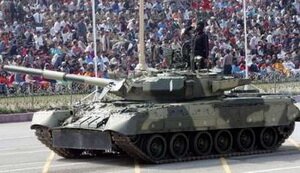 |
|
Pakistani T-84 tank on parade in Islamabad http://www.pakistan33.com/ |
It was for the sake of fulfilling the Pakistani contract that the then leadership of Ukraine managed to quickly and accurately establish a complete closed cycle of production of armored vehicles. Within a very short period of time, using the potential of different enterprises of Ukraine, various commercial schemes in buying necessary equipment and the outstanding at the time work of Ukrainian scientific and technical intelligence service, actually within a year the full cycle of production of tanks was up and running [4].
The Pakistani contract clearly demonstrated the high level of the Ukrainian tank industry, which by most of the parameters is up to international standards. But it also showed the need for further work in two directions — improvement of the existing basic designs of tanks of Kharkiv production (first of all for export) and development of a radically new tank. However, fulfillment of the second task was slowed down by the lack of theoretically justified perspectives (economic, political and strategic) of development of tanks and tank forces in Ukraine — and this without taking into account thousands of highly skilled professionals and practitioners and complete theoretical and practical elaboration of purely technical aspects. One thing was clear — the Ukrainian Army need one and only, universal type of main tank, instead of a range of types that were in its arsenal. Moreover, taking into consideration financial and economic difficulties in Ukraine itself, there was no hope for the state's order on a promising tank. But the effect of the Pakistani order did fuel a number of countries' interest in the Ukrainian tanks, which stimulated further development of designers' works.
More clear was the picture in the sphere of light armored vehicles. We mean armored personnel carriers and infantry fighting vehicles. The first — Soviet BTR-60PB, BTR-70 and BTR-80 along with some positive qualities had significant drawbacks — the not quite successful layout, greatly complicating the conduct of hostilities both, on BTR's and during dismounting. Besides, these types of BTR weapons (14.5-mm and 7.62-mm machine gun in a small turret with manual control) did not meet modern requirements. Besides, the complicated arrangement of two carburetor engines at the same time on the first two samples required constant professional servicing that, otherwise easy to use, military equipment.
As for the BMP, the power base of infantry units of the Ukrainian Armed Forces was BMP-1 and BMP-2. The first was criticized immediately after its creation for its poor armament (73-mm smoothbore gun 2A28 “Grom”). Experience of many local conflicts showed that it was absolutely ineffective. BMP-2, due to the installation of a 30-mm automatic gun 2A42 in a two-seater tower, partially allowed to eliminate this drawback. However, BMP-2 had weak armor and non-optimal layout.
The experience of the war in Afghanistan of 1979-1989 clearly demonstrated that with the use of Soviet BPM's it was not so much the matter of heavy technical losses as of human ones. And especially in low-intensity conflicts, where actively were used mining and manual antitank grenade launchers. That is why in Afghanistan, Soviet military servicemen were moving not within the vehicle, but on the body of the BMP (”on the armor”). And although they were vulnerable during shelling, they won the time when dismounting and had a chance to survive in case of a landmine explosion (except for the driver, on BMP-1 — except for the driver and the commander).
Interestingly, the experience of trainings in the Group of Soviet Forces in Germany and, especially, of the National People's Army of the GDR showed complete adequacy of the Soviet BMP's to participate in a full-scale classic war of high intensity.
However, in 1990 Ukraine was not threatened by such a war, even theoretically. The more urgent task was to adapt the domestic military equipment to the conditions of modern local conflicts. Those conditions demanded significant strengthening of BMP's armor (even to the level of tanks) and increasing of capacity of various weapons for shooting at different types of targets. To achieve this engineers could sacrifice the infantry combat vehicles' ability to independently pass, at least, water obstacles. As for BTR's, apart from strengthening the quality of weapons, the most important became the problem of creating new layouts to increase the comfort of the crew and the assault force, as well as to solve the problem of quality of protection from landmine explosions.
Another incentive was the prospect of modernization of Soviet samples of light armored vehicles which were in service in armies of more than 100 countries. Serious competitors in this issue for the Ukrainian defense industry could be only the MICs of Russia and Belarus, and partly — Israel, South Africa and China's firms. That is why the state, which was the first to offer quality and cheap schemes of modernization, would be able to take a fairly large segment of the market.
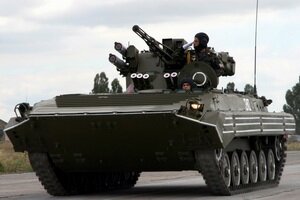 |
|
Ukrainian BMP-1U with module “Shkval” http://www.military-informer.narod.ru/ |
Ukrainian specialists did know this perfectly well, as did the heads of the units responsible for specific export policy of the state. Otherwise, the export potential of the Ukrainian armored vehicles could only relate to the tanks. However, the competition at their sale on the world market already in the early 1990s was very high. This was clearly demonstrated by the failure of Brazil and partially of France in the promotion of the export of their latest models (”Ozorio” and “Leclerc”, respectively), and at the beginning of the XXI century Ukraine faced this problem at the Turkish tank tender.
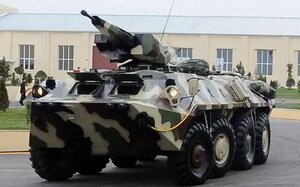 |
|
Ukrainian BTR-3E1 with the universal module “Shturm”, built for Thailand http://andrei-bt.livejournal.com/ |
It should be noted that Ukrainian tank builders qualitatively and systematically approached the modernization and establishment of appropriate armored vehicles. They determined not only the ways of modernization of the existing BMP's and BTR's, but also directions for creation new armored vehicles. In the first case, Ukraine was perhaps the first country in the world, which made a bid for special combat modules, fully equipped with samples of weapons of Ukrainian development and production. These modules could easily be mounted on BMP and BTR, did not require additional training of personnel, and the variety of weapons provided the upgraded vehicles with universal qualities.
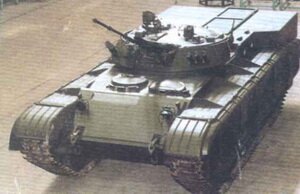 |
|
The first “Kharkiv” version of the Jordanian heavy IFV “Temsah” http://btvt.narod.ru/ |
As for the creation of new samples, the experience of local conflicts required first of all, reliable protection. That is why it was logical to create the proper equipment on the basis of existing tanks or trucks, which were being produced at the famous worldwide Kremenchug Automobile Plant (KrAZ). Especially because export orders helped here too.
Thus, at the end of the 1990s, the Jordan's army leadership asked Kharkov designers to develop a project to modernize the outdated British tanks “Centurion” [5], turning them into infantry fighting vehicles (known as “Temsah”). Ukrainian specialists in short time developed this project, and then improved the experience gained on the T-64 and T-72 tanks.
On the basis of a first version of the Jordanian heavy IFV was created a diverse range of vehicles, the most original of which should be considered a wheeled infantry fighting vehicle BMP-K-64 and heavy BTR-64E. On the basis of T-72 was also made a heavy IFV — BMT-72, on the outside not differing from the base tank. But after 10 years already the Iraqi order for wheeled APC's (not taking into consideration the fact that to a large extent it was not economic, but political contract) contributed to the creation in Ukraine of a fundamentally new layout of the BTR-4.
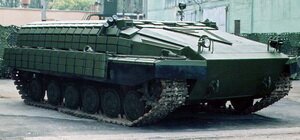
|

|
|
Heavy and wheeled infantry fighting vehicles on the basis of the T-64 tank |
|
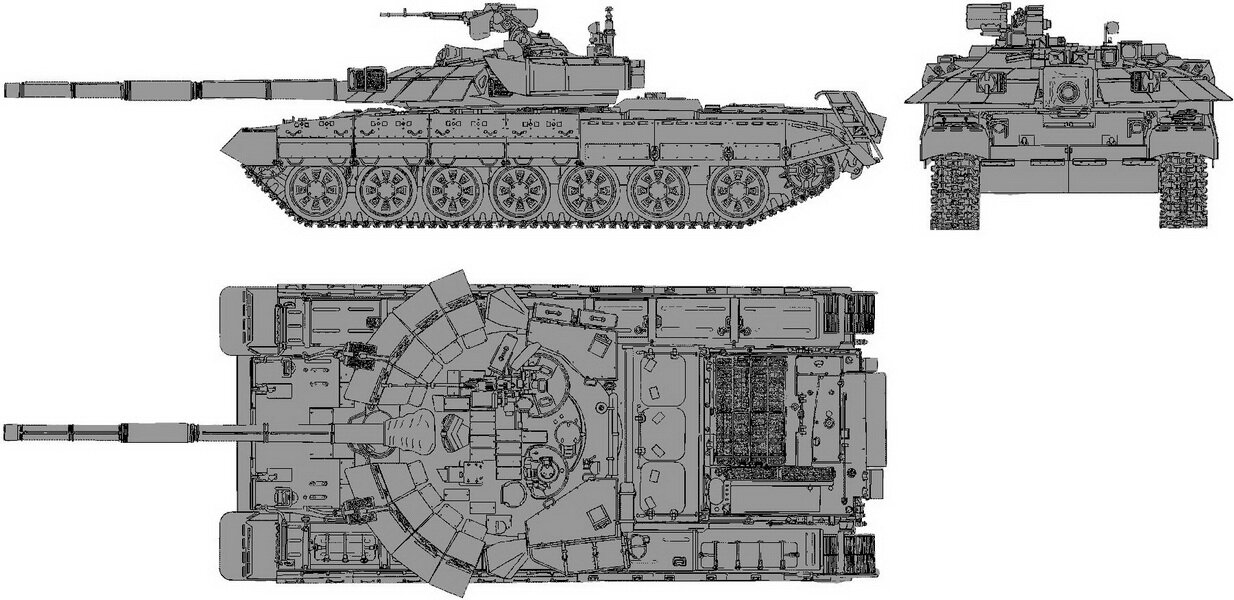 |
|
Projections of the Ukrainian modernization of the T-72 into the heavy infantry fighting vehicle BMT-72 http://www.morozov.com.ua/ |
As a result, by the beginning of the second decade of the 21st century, the Ukrainian armored vehicle building branch had got a whole spectrum of combat vehicles that were not only up to the requirements of the time, but in the case of adopting, would give the Ukrainian Army fundamentally new qualities. Firstly, we mean the newest main battle tanks “Oplot” and modernized T-64BM “Bulat”. Their characteristic feature is a new concept of armoring (built-in and mounted dynamic protection and fully welded body and tower), active protection systems “Nizh” and “Warta”, newest guided weapons in the form of tank missiles “Kombat”. Secondly, tank support combat vehicles and infantry fighting vehicles, created on the base of the tank. Thirdly, BTR-4 — absolutely new in layout and universal on the ability to mount weapons in the form of towers and combat modules. Its only disadvantages are weak defense of the body, especially from mine explosions, and not the best design of the front of the body. However, already in 2013, was created BTR-4MV, where all the above-mentioned drawbacks have been removed. And finally — the upgraded (by installing of a variety of combat modules) BMP-1U and BTR-70 versions of the BTR-3 and BTR-7.
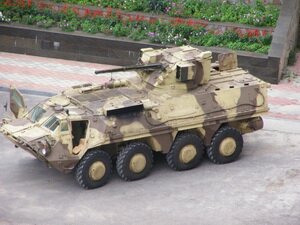 |
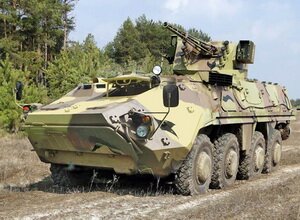 |
|
Early (BTR-4E) and late (BTR-4MV) versions of the first purely Ukrainian armored personnel carrier http://www.ukraineindustrial.info/ http://topwar.ru/ |
|
It should be noted that all the new Ukrainian armored vehicles were created to NATO standards, and BTR-4 was adopted by the Armed Forces of Ukraine in the export version [6]. As for modernized by Ukraine samples of the old Soviet equipment, the Ukrainian experts (at least in Azerbaijan, Kazakhstan and Turkmenistan) have made bug-free all the aspects related to its improvement. Moreover, on the basis of any Soviet military vehicle they developed projects turning it into equipment that was almost completely outdated. Striking confirmation of this is modernization of Peruvian T-55 [7].
However, with the outbreak of war in the Donbas, it became clear that the Ukrainian Armed Forces in terms of armor remained at the level of 1992. And the armored vehicles themselves were so few that the most “modern” weapons of Ukrainian servicemen have become improvised armored vehicles — “Pantserniks”.
Makeshift Armored Vehicles
The experience of some internal armed conflicts of the 20th century demonstrated usefulness of makeshift armored vehicles. The most famous are: the Spanish Civil War of 1936-1939 (it still holds the record for the number of created improvised armored cars), Israel's War of Independence (First Arab-Israeli war of 1948-1949, where makeshift armored vehicles, under the title “sandwiches” very active and performed well in fulfilling tasks of main tanks and armored personnel carriers) and the current civil war in Syria.
While in the first two cases, makeshift armored vehicles were used by all opposing forces, because the standard tanks and armored cars were not enough, in the Syrian internal war, improvised armored vehicles were in the role of an insurgent alternative to main tanks, infantry fighting vehicles and armored personnel carriers of the government troops. However, unlike the aforementioned conflicts, the ATO in Eastern Ukraine is fundamentally different from them. First of all because the makeshift armored vehicles began to be used not by separatists or “militias” (as they are called by Russian media) of DPR and LPR, but by the troops of Ukraine... And not by nearly unarmed volunteer formations, but by regular Armed Forces of Ukraine [8].
This fact clearly indicates the almost critical state of affairs in the Armed Forces of Ukraine, which from the beginning of the ATO in Donbas only at first glance could be considered a modern European army, in terms of weapons included. Thus, according to the “White Paper 2013” of the Ministry of Defense of Ukraine, the Army had on the balance sheet only 683 main battle tanks and 1965 armored combat vehicles [9]. Western data for spring of 2014 are more optimistic — 1140 T-64 in service and 700 tanks T-80 and T-72 in storage; 1657 infantry fighting vehicles and 770 armored personnel carriers [10]. Anyway, the situation with the equipment was very bad.
Suffice to say that in all the years of independence of Ukraine the Army had received only 10 new (T-84 “Oplot”) and 85 upgraded tanks (T-64BM “Bulat”), 13 latest BTR-7 and a certain number of upgraded BMP-1U, BTR-70DI and multiple rocket launchers BM-21 “Grad” (in “Bastion-1” and “Bastion-2” versions). Since 2009 the Army had not received a single out of the 50 newest ordered tanks BM “Oplot”, and since 2012 — not a single of the adopted BTR-4 [11]. The situation with the use of military equipment was also unsatisfactory. What can we talk about if at the outbreak of war in the Donbas, Commandment of the Armed Forces of Ukraine threw into combat the unique Soviet BMP-3, which Ukraine had in the amount of only two (2) pieces, and the most advanced self-propelled howitzers “MSTA-S” in the amount of 15 pieces (out of the 40 that remained in Ukraine as of 1992), which had been in service with the 24th Mechanized Brigade, stationed near Lviv [12].
In these circumstances, creation of makeshift armored vehicles was an adequate response to the inadequate situation. But the uniqueness of this process was that armoring of civil vehicles (the so-called “revetting”) and creation on their base of combat vehicles occurred after the original experiments conducted in regular units of the Armed Forces of Ukraine both, before the beginning of hostilities in the Donbas and after. And in fact, these experiments were conducted on the principle “saw, but did not consider the theory” which ensured maximum half result.
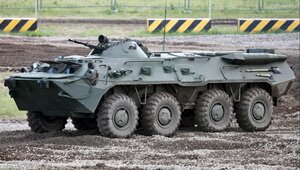 |
 |
|
Ukrainian BTR-80 of the 95th Airmobile Brigade in 2012 and in the period of ATO http://scout-thedeaddistrict.blogspot.ru |
|
The result has been a transfer of the process of revetting from army units to specialized (and not quite specialized) plants and enterprises, specialists of which also were not always familiar with the theory, and to private workshops of motorists and public organizations. It should be noted that, despite the strange exclusives, created at “dawn” of the process of revetting (like, for example, the armored mobile checkpoint for the State Border Service made in Mykolaiv on the basis of BRDM-2 [13], by the autumn of 2014. Ukrainian patriots have achieved in this matter great results. Their theoretically grounded and turned into reality ideas can help bring the Ukrainian armored industry to a new level.
No need to tell about all the revetted makeshift vehicles in Ukraine of summer-autumn 2014. Note that in this process are involved individual citizens, businessmen, MPs, voluntary organizations, various factories of heavy industry, automobile enterprises and bus fleets of individual cities, prisons, rear bases of volunteer battalions and so on. Today the Armed Forces, National Guard and volunteer formations have already received over 200 revetted armored vehicles, both, created on the basis of purely civilian traffic and resuscitated decommissioned military equipment. At this, the makeshift armored vehicles can be divided into certain groups according to their intended purposes.
First of all, for special intelligence subunits of regular or volunteer units fighting in the East of Ukraine. They need fast and at the same time light vehicles, taking on board, apart of the regular crew, additional fighters or the wounded for transportation, while not losing their dynamic characteristics. Despite the fact that at the Kremenchug Automobile Plant in 2013-2014 were made “Koguar” and “Spartan” (government's order of 2014 is for 60 and 310 of these vehicles, respectively) [14], Kiev firm “Praktika” was developed and tested an armored car “Cossack” and at the Kharkiv Malyshev Plant was made the subsequently adopted “Dozor” (by the way, its license has already been bought by Poland), these vehicles are still very few. And this is despite the fact that such armored vehicles as such are an absolutely new and surprisingly successful line of armored Ukrainian industry, and fully meet the requirements of the modern world. Therefore, most of the makeshift armored vehicles are created especially for this purpose.
And here we should distinguish the Kiev club “Militarist”. Its enthusiasts began in June 2014 to create for the “Kievan Rus” battalion armored cars under the name “Scorpion”. Unlike other makeshift structures, Kiev enthusiasts have created on the basis of standard civilian jeeps fully modern military vehicles. To do this, they did not put armor panels on the body of a standard automobile. They replaced the entire body of the car. As a result, the dynamic characteristics of the car survived, but it got the already optimized for military use universal armored body and mounted weaponry in the form of machine-gun or missile systems. In fact, Kiev enthusiasts have created in absolutely primitive conditions a version of the famous Israeli reconnaissance armored vehicle RAM, which has not just been functioning perfectly well in the Israeli Defense Army for almost 40 years, but also has been successfully exported.
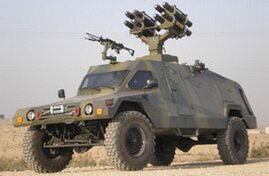 |
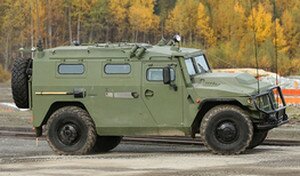 |
|
Armored vehicles RAM (one of the latest versions) and “Scorpion 2” (September 2014) http://forum.militarist.ua |
|
The second direction is demonstrated by the State Enterprise “Atomremontservis” (Kiev), where during August-September 2014 were armored, at least 2 buses and 3 cars. The original scheme of armoring of buses and minibuses shows a universal approach to the protection of the vehicles of rear units, forced to move about predominantly singly. Moreover, such a scheme is the application for the adaptation of vehicles of wartime to peacetime needs (e.g. for cash carrying).
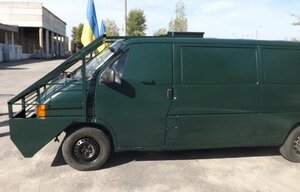 |
 |
|
Armored vehicles created by the company “Atomremontservis” http://www.energoatom.kiev.ua |
|
Finally, the third direction, which theoretically should become the leading one, which show already powerful machine building plants of Zhmerynka and Kyiv (”Leninska Kuznya”). Designers of these companies have created on the basis of the famous Soviet truck GAZ-66 respectively: an armored personnel carrier and a universal war vehicle — an analogue of the world-famous American “Hummer”. Despite the different approaches and technological equipment of the two factories, both vehicles meet modern requirements (e.g., the APC has composite armor — steel-rubber-steel) and, most interestingly, are cheap enough (2.5 and 10 thousand US dollars respectively). Taking into consideration the fact that Ukraine has in the warehouses, at least 10 thousand GAZ-66, and about 60 thousand are in the civil and military use, modernization of simple and obsolete Soviet trucks can bring to the state and its Armed Forces quite a great profit.
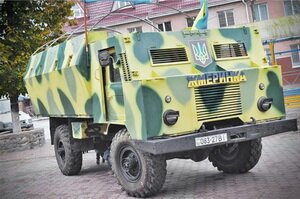 |
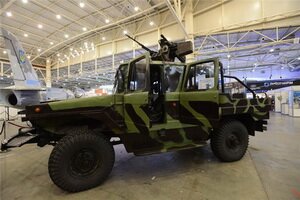 |
|
Ukrainian BTR and a universal combat vehicle based on GAZ-66 http://strangernn.livejournal.com/ http://strangernn.livejournal.com |
|
Conclusions and recommendations
It is assumed that, in deciding to reequip the Army of Ukraine, heads of the Defense Ministry, the government and the Supreme Commander should bear in mind, first of all, the potential of the Ukrainian MIC, creative ideas of its specialists and combat experience of the Ukrainian military operating in the area of ATO. They also should take into consideration interesting works of creators of modern Ukrainian makeshift armored vehicles. Taking into account that Ukraine is a capitalist state by its nature, adequate distribution (according to the Article 1 of the Constitution), of relatively limited means of the military budget and job creation in approving future government's military orders should be at a decent level.
Full, even temporarily (for the duration of ATO) loading of modern enterprises of the Ukrainian MIC with orders production of weapons for the Army is a very urgent task. At this, due to the loss of a number of defense enterprises in the Crimea and Donbas, it is very important to quickly find a replacement for preserving at least of the closed cycle of creation of armored vehicles. Moreover, the task in 2014 is much easier than the similar task of the time of the Pakistani (1996-1998) contract. For example, Feodosia Optical Plant which was manufacturing equipment for tank sights, can be substituted (of course, with appropriate equipment) by one of similar plants of Kiev, Lviv or Kharkiv.
Should be taken into account the fact that in Ukraine the current situation is rather strange. Domestic enterprises (and not necessarily strictly military) can both, produce modern military equipment “from scratch” and upgrade, in accordance with the requirements of the time, a large number of tanks, armored vehicles, artillery systems and automobiles. At this, the potential of the latter resource is significant enough — at least 2 thousand armored vehicles, nearly 4 thousand pieces of artillery systems, tens of thousands of automobiles and hundreds of thousands of small arms. Rational is the parallel advancement of two programs — for production of new and modernization of old weapons, including by a significant expansion of existing, or perhaps even creating new businesses. There is nothing dangerous for the economy of Ukraine here. It is enough to learn the experience of the military industry of the Islamic Republic of Iran during the war with Iraq (1980-1988), when the majority of combat vehicles were repaired and modernized in small workshops with staff of 5-20 people. The fact that extremely quickly many state automobile workshops master the repair and improvement of the most modern civilian vehicles from leading manufacturers only shows that there are no special difficulties for Ukrainian engineers and workers here.
Another thing is time. Making modern tank “from scratch” takes (depending on the design) 9 to 14.5 months. Already now the Kharkiv Malyshev Plant can get on the pace, at least of 10-15 units per month. Modernization of the same old tank takes 5 to 12 months, with a minimum at 3 plants with the same pace. So, at the minimum pace of work of the armored vehicle industry, Ukraine's Armed Forces can monthly get one completely reequipped with the latest equipment tank battalion. In this case, even in the situation of the ATO, with adequate funding the Army of our state can be fully re-equipped with tanks within 3 to 5 years. As for other armored vehicles, here the variety of its products, and the number of units ordered can vary depending on the needs of Ukrainian military formations. Say, specialized enterprises can focus on upgrading existing BMP’s (or on turning heavy tanks into heavy BMP’s and BTR’s) and making the latest BTR-4MV, which only in a limited number will be supplied to the formations in the area of ATO, and will primarily come into service in combat units of strategic reserve. Simultaneously, noncore businesses will be able to produce APC’s and armored vehicles based on civilian cars and to upgrade old BMP-1 and BTR-70 by installing universal combat modules. And this equipment, (the number of which will grow, while its costs will decrease) will come into the zone of the ATO and give Ukrainian soldiers the advantage over the separatists in mobility and security. Actually, other options or their combinations are also possible.
It is necessary to create in the sphere of production of weapons for the Army of Ukraine of certain autonomous districts. Today it is possible to create 2 to 4 such districts. In fact, Kharkiv armoured industrial district already exists. But its location is extremely dangerous from the political and strategic point of view. That is why the union of Kyiv and Zhitomir armored repair plants, SE “KBAO” and KB “Luch” with existing businesses or those that can potentially appear, can lead to the creation (and, in the shortest time) of Kyiv armored industrial district. At this, at one of the plants of this region should begin production of main combat tanks “from scratch”.
The other two potential districts — Lviv and Mykolaiv — can work on a radical modernization of existing armored vehicles. Moreover, it is advisable in Mykolaiv to develop production of universal combat modules, not only for the Ukrainian Army, but for the Ukrainian Navy as well, which will soon become a very urgent task.
Another urgent task for modern Ukrainian defense sector will be deploying of its own and mass production of field artillery systems. Ukraine already has design developments of some systems. A certain government's order, adequate funding and some control over disbursements, could theoretically lead to the launch of a series of exclusively Ukrainian systems. It is assumed that enterprises of the Center and East of the state are able to deploy production of systems with a caliber of more than 100 mm, but the enterprises of the North and West — of various systems of small and medium caliber.
An alternative might be purchase from leading western manufacturers of appropriate artillery systems. However, we should bear in mind that historically and traditionally artillery systems of Soviet (now Russian production) are significantly better than their Western counterparts. That is why the program for buying military equipment for missile and artillery troops of Ukraine should be selective. And, strange as it might seem, as a model here you can take the modern Azerbaijan. Taking into consideration the experience of this Caspian state, Ukraine should be after the unique Israeli 120-mm mortars CARDOM, 155-mm self-propelled artillery systems like the Israeli ATMOS-2000, the South Korean K-9 or the Turkish T-155 Firtina (or their German or British counterparts, the cost of which is quite high), 300-mm MLRS of the Turkish T-300 Kasirga or Israeli 300-mm Lynx Extra. Everything else the Ukrainian state can and should develop and make itself.
Notes:
- And again about the tank “Oplot” // http://bmpd.livejournal.com/677367.html
- T-90 // https://ru.wikipedia.org/wiki/%D0%A2-90
- Shmelyov I., History of the tank. 1916-1996. — M., 1996. — P. 180
- Armoured military equipment of Ukraine: results, potential prospects... // http://btvt.narod.ru/4/Ukraine/ukraina_1991_2006.htm
- Jordan heavy IFV “Temsah” (AB-14) // http://btvt.narod.ru/4/temsah/temsah.htm
- BTR-4E adopted for service in Ukraine // http://bmpd.livejournal.com/298618.html
- http://www.morozov.com.ua/rus/body/t55_tifon2.php
- On a gloomy, unscheduled... // http://strangernn.livejournal.com/980983.html
- The White Book of 2013. — K., 2014. — P. 67
- Ukraine: Main land and air force dispositions // http://www.iiss.org/en/regions/russia/ukraine-graphic-c106
- The Army of the Armed Forces of Ukraine // http://uk.wikipedia.org/wiki/%D0%A1%D1%83%D1%85%D0%BE%D0%BF%D1%83%D1%82%D0%BD%D1%96_%D0%B2%D1%96%D0%B9%D1%81%D1%8C%D0%BA%D0%B0_%D0%97%D0%B1%D1%80%D0%BE%D0%B9%D0%BD%D0%B8%D1%85_%D0%A1%D0%B8%D0%BB_%D0%A3%D0%BA%D1%80%D0%B0%D1%97%D0%BD%D0%B8
- Will BMP-3 help the Ukrainian Army? // http://www.vestnik-rm.ru/news-4-8127.htm; Ukrainian army loses SAU “MSTA-S” // http://bmpd.livejournal.com/969813.html
- Border guards have received a mobile checkpoint created at Mykolaiv Mechanical Repair Plant // http://nikvesti.com/news/politics/55206
- https://www.facebook.com/arsen.avakov.1/posts/678562318900544

